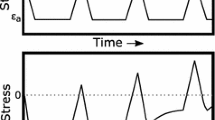Abstract
Breakaway oxidation or chemical failure has beendescribed in this paper in terms of two possiblemechanisms and applied to the behavior of achromia-forming 20Cr-25Ni austenitic steel. Bothmechanisms relate to the depletion of chromium arisingfrom its selective oxidation and quantitative modelingof the depletion profile is used to identify thedominant chemical-failure mechanism as a function oftemperature. Intrinsic Chemical Failure (InCF) develops whenthe chromium concentration within the alloy at theoxide-metal interface is less than that in equilibriumwith chromia. This occurs at high temperatures, typically above 1390 K, but the temperature atwhich the alloy becomes susceptible to this form offailure increases as the alloy grain size decreases. Atlower temperatures, chemical failure is associated with the general depletion of chromium acrossthe specimen section to a level below which reformationof a healing chromia layer will not occur, should thesurface layer become damaged. In this regime, failure is termed Mechanically Induced ChemicalFailure (MICF).
Similar content being viewed by others
REFERENCES
P. Hancock and J. R. Nicholls, Mater. Sci. Technol. 4, 398 (1988).
M. Schütze, Int. J. Pressure Vessels Piping 47, 293 (1991).
H. E. Evans, A. Strawbridge, R. A. Carolan, and C. B. Ponton, Mater. Sci. Eng. A225, 1 (1997).
J. R. Nicholls, H. E. Evans, and S. R. J. Saunders, Mater. High Temp. 14, 5 (1997).
H. E. Evans, D. A. Hilton, R. A. Holm, and S. J. Webster, Oxid. Met. 14, 235 (1980).
H. C. Cowen and S. J. Webster, in Corrosion of Steels in CO2, D. R. Holmes et al., eds. (British Nuclear Energy Society, London, 1974), p. 349.
B. D. Bastow, D. P. Whittle, and G. C. Wood, Oxid. Met. 12, 413 (1978).
W. J. Quadakkers and M. J. Bennett, Mater. Sci. Technol. 10, 126 (1994).
J. P. T. Vossen, P. Gawenda, K. Rahts, M. Rohrig, M. Schorr, and M. Schütze, Mater. High Temp. 14, 387 (1997).
I. G. Wright, B. A. Pint, C. S. Simpson, and P. F. Tortorelli, Mater. Sci. Forum 251– 254, 195 (1997).
H. E. Evans, D. A. Hilton, and R. A. Holm, Oxid. Met. 10, 149 (1976).
A. F. Smith and G. B. Gibbs, Metal Sci. J. 3, 93 (1969).
H. E. Evans and A. T. Donaldson, Oxid. Met., 50, 457 (1998).
R. C. Lobb and H. E. Evans, Materials for Nuclear Reactor Core Applications (British Nuclear Energy Society, London, 1987), p. 335.
R. J. Hussey, D. F. Mitchell, and M. J. Graham, Werkst. Korros. 38, 575 (1987).
P. I. Williams and R. G. Faulkner, J. Mater. Sci. 22, 3537 (1987).
R. C. Lobb and H. E. Evans, in Microscopy of Oxidation, M. J. Bennett and G. W. Lorimer, eds. (Institute of Metals, London, 1991), p. 119.
R. C. Lobb and M. J. Bennett, Oxid. Met. 35, 35 (1991).
H. E. Evans and R. C. Lobb, Corros. Sci. 24, 223 (1984).
O. Kubaschewski, E. Ll. Evans, and C. B. Alcock, Metallurgical Thermochemistry (Pergamon Press, London, 1967).
E. D. Richardson, J. H. E. Jeffes, and G. Withers, J. Iron Steel Inst. 166, 213 (1950).
R. Hales, A. F. Smith, and J. C. Killeen, in Corrosion of Steels in CO2, D. R. Holmes et al., eds. (British Nuclear Energy Society, London, 1974), p. 311.
H. E. Evans, D. A. Hilton, R. A. Holm, and S. J. Webster, Oxid. Met. 12, 473 (1978).
D. Caplan, A. Harvey, and M. Cohen, Corros. Sci. 3, 161 (1963).
D. Caplan and G. I. Sproule, Oxid. Met. 9, 459 (1975).
E. A. Gulbransen and K. F. Andrew, J. Electrochem. Soc. 104, 334 (1957).
Rights and permissions
About this article
Cite this article
Evans, H.E., Donaldson, A.T. & Gilmour, T.C. Mechanisms of Breakaway Oxidation and Application to a Chromia-Forming Steel. Oxidation of Metals 52, 379–402 (1999). https://doi.org/10.1023/A:1018855914737
Issue Date:
DOI: https://doi.org/10.1023/A:1018855914737




